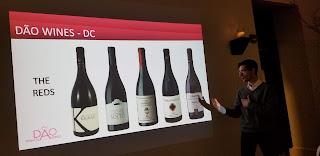That being said, the modern indigenous grape varieties grown in Portugal are Vitis Vinifera and includes grapes such as Malvasia Fina, Encruzado, Jaen (Mencia), and Baga, as well as Touriga Nacional and Tinta Roriz (Tempranillo). These grapes excel in the Dão viticultural region's granite soils and are favored with the microclimates within this northern Portuguese region. It is enclosed by four mountain ranges which act as natural barriers from the coastal rains that originate from the Atlantic and the strong continental winds emanating from Spain. Vineyards are generally planted between 1300 to 1600 feet with higher elevations reaching 2600 feet. According to Wine-Searcher.com, "This elevation raises the vines out of the valley's shadows and towards all-important sunshine, allowing them to maximize their photosynthesis time during the day. It also increases diurnal temperature variation, helping the grapes cool down at night, which they must do to retain the acids so desirable in wine".
 |
| Courtesy of Vinhos Dão Wine |
Selected Harvest: With harvest year, with outstanding organoleptic characteristics and with more than 1% of the volume of the legal limit.Our tasting started with a flight of white wines dominated by the Encruzado grape. According to Wines of Portugal, Encruzado generally creates complex wines with aromatic mineral notes and tropical fruit and depth and vanilla when fermented in barrel. The Quinto do Mondego Mondeo Branco 2018 (60% Encruzado & 40% Gouveio) contains these mineral notes as well as a smokey, flinty profile. The grape's versatility was shown in the saline driven high acid Juliana Kelman Encruzado 2018 to the beeswax and spice in the Pedra Cancela Vinha da Fidalga Encruzado 2018 the cream and depth of the Quinta dos Roques Encruzado 2018.
Reserve: With harvest year, with outstanding organoleptic characteristics and with more than 0.5% of the volume of the legal limit.
Garrafeira: With harvest year, with outstanding organoleptic characteristics;
> Red wines: 36 months, 12 months in bottle
> White wines: 12 months, 6 months in bottle
Dão Nobre: With the year of harvest, with very outstanding organoleptic characteristics. Only two to date (one white and one red) – Must score 90 points plus
For reds, our hosts provided one flight consisting of various blends and the second flight of 100% Touriga Nacional. Like most European regions, blends are the backbone of the Dão with most combinations not as complex as the Casa da Passarella "O Oenologo - Vinhas Velhas" Tinto 2015 - composed of Baga, Touriga Nacional, Alvarelhão, Tinta Pinheira, Jaen, Alfrocheiro, Tinta Carvalha, and more. And the Pedra Cancela Selecao do Enologo Tinto 2016 (Touriga Nacional, Alfrocheiro, Tinta Roriz) was the bargain of the tasting, priced under $10, with gripping tannins and solid fruit structure and just a little less leather and barnyard funk as the winery's more expensive Reserva.
The 100% Touriga Nacional wines, in general, provided more fruit than the blends particularly the Borges Touriga Nacional 2017. But expect a balanced profile with texture and solid tannins. The Julia Kemper Touriga Nacional 2012 was more tender due to the advanced aging and provided more approachable tannins. My favorite was the dustier Jaime de Almeida Barros "Quinta das Camelias" Touriga Nacional 2016 which seemed a perfect match with the Martin Farms Beef Short Rib -- the main entree during our lunch at Metier.
The final wine was the Qunita das Maias Tinto Jaen 2017, my first single varietal from this grape. It offers a rustic charm with dusty cherries and firm tannins. This wine and the others will entice a more in-depth examination of the Dão region and Portuguese wines.
Felicidades to Vinhos Dão Wines, Wines of Portugal, and Metier for a fantastic tasting.
















































